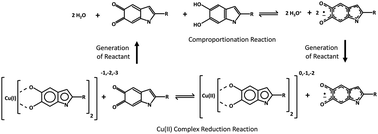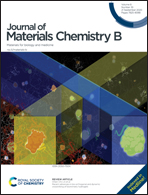Abstract
Long range electrical conduction in biomaterials is an increasingly active area of research, which includes systems such as the conductive pili, proteins, biomacromolecules, biocompatible conductive polymers and their derivatives. One material of particular interest, the human skin pigment melanin, is a long range proton conductor and recently demonstrated as capable of proton-to-electron transduction in a solid-state electrochemical transistor platform. In this work, a novel “doping strategy” is proposed to enhance and control melanin's proton conductivity, potentially enhancing its utility as a transducing material. By chelating the transition metal ion Cu(II) into the bio-macromolecular matrix, free proton concentration and hence conductivity can be modulated. We confirm these observations by demonstrating enhanced performance in a next generation electrochemical transistor. Finally, the underlying mechanism is investigated via the use of a novel in situ hydration-controlled electron paramagnetic resonance study, deducing that the enhanced proton concentration is due to controlling the internal solid-state redox chemistry of the intrinsic polyindolequinone structure. This doping strategy should be open to any transition metal ions that bind to hydroquinone systems (e.g. polydopamine). As such, the tailoring strategy could make other soft solid-state ionic systems more accessible to applications in bioelectronics, leading to the creation of higher performance ion–electron coupled devices.



 Please wait while we load your content...
Please wait while we load your content...